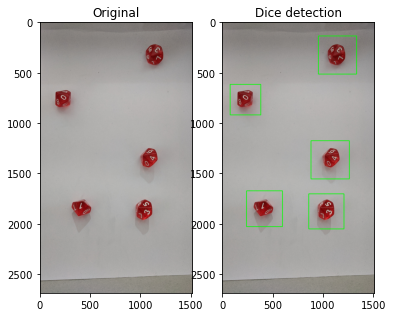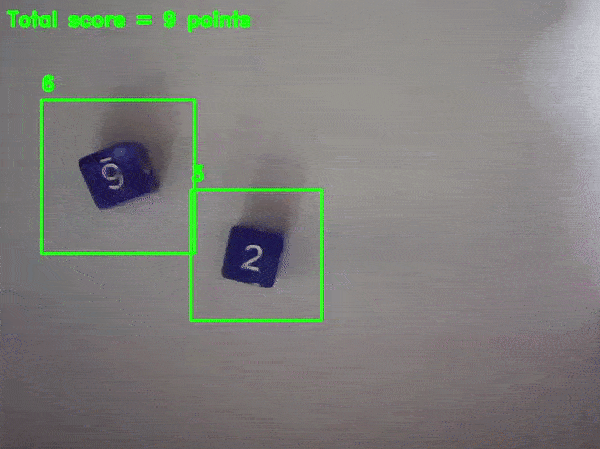Dice Scores Recognition in image/video
Image recognition is a hot topic with multiple applications. In this final project I used modern techniques to extract the numbers resulted from dice throws in an image or a video. For this work I conducted the following steps:
-
Built the train dataset using my camera to obtain multiple images.
-
Segment images to extract the region of the dices.
-
Used Convolutional Neural Networks (CNN), identified the dice type and computed the number.
-
Adapted the code to work with images or live video using a webcam.
In the main_project.ipynb jupyter notebook with the necessary line codes to execute this project. Due to the file sizes, neither the dataset nor the models were uploaded to GitHub.
Dataset creation
In order to create a dataset to train a CNN, I recorded videos of each number in each dice in different angles and different lights. After that I extracted the video frames, cropped them and save into image files. Some of these images were sent to the corresponding train folder and other to the test one (~20% test).
Image segmentation
Using these fotograms, I trained a Haar Cascade Classifier with OpenCV and the Cascade Trainer GUI in order to be able to recognize the dices, following this video tutorial by OMNES. I recorded some background frames as well to provide to the Cascade Classifier positive and negative images. This provided a good detection of the dices as seen in the picture
With these image segmentation techniques, I conducted one last preprocessing to the image dataset. I selected better the region of the dice to extract more centered and focused images of the dices before training the CNN.
CNN modeling
The initial dataset is augmented using Keras' ImageDataGenerator to take into account different angles of the dice, shifts with respect to the center of the square and changes in light.
I used TensorFlow in order to create and fit a CNN with the following parameters:
Model: "sequential"
_________________________________________________________________
Layer (type) Output Shape Param #
=================================================================
conv2d (Conv2D) (None, 100, 100, 32) 896
_________________________________________________________________
max_pooling2d (MaxPooling2D) (None, 50, 50, 32) 0
_________________________________________________________________
conv2d_1 (Conv2D) (None, 50, 50, 64) 18496
_________________________________________________________________
max_pooling2d_1 (MaxPooling2 (None, 25, 25, 64) 0
_________________________________________________________________
conv2d_2 (Conv2D) (None, 25, 25, 128) 73856
_________________________________________________________________
max_pooling2d_2 (MaxPooling2 (None, 12, 12, 128) 0
_________________________________________________________________
conv2d_3 (Conv2D) (None, 12, 12, 256) 295168
_________________________________________________________________
max_pooling2d_3 (MaxPooling2 (None, 6, 6, 256) 0
_________________________________________________________________
flatten (Flatten) (None, 9216) 0
_________________________________________________________________
dense (Dense) (None, ***Number of dice faces***)
=================================================================
I used this schema to fit the D6 and D10 dices.
Score recognition in images and live video
After that we have prepared all the tools necessary to build this project. I used photos of dices in different positions as seen in the image from the "Image Segmentation" section to predict the scores of several dice throws.
- The D6 dices are almost generally predicted, except for maybe blurry images or with some shiny spots in dices that make the algorithm confused
- The D10 dices are more problematic due to the particular shape, but even so, a fraction much higher than the random 10% is guessed. In particular, some dices that are seen with some angle are misclassified.
Finally I could connect the webcam with the python code, so I can test my approach in real time using OpenCV. Each frame is processed by the Cascade Classifier and the CNN is applied to each detected dice region.
Final thoughts
I used homemade methods to create the sample and to process the images and videos. Even so, and taking into account that this was done in one week, the CNN and OpenCV are able to perform high quality detection and classification of objects. These kinds of works have a great potential in a wide range of fields.




